Development Framework for Agro-Based Industries in Secondary Cities of Sindh Province, Pakistan: SWOT Analysis of Ten-Year Perspective and Medium-Term Development Framework Plans
Abstract
:1. Introduction
2. System of Secondary Cities in Sindh Province
3. Agro-Based Industrial Development in Sindh Province
4. Methodology
4.1. Data Collection
4.2. Data Analytical Approach
5. Results
5.1. Ten-Year Perspective Plan (2001–2010)
5.2. Medium-Term Development Framework Plan (2005–2010)
5.3. SWOT Analysis Results of Ten-Year Perspective and MTDF Plans
5.3.1. Strengths of Ten-Year Perspective and MTDF Plans
- Ninety percent of key informant claimed that the ten-year perspective plan presented planning strategies for the establishment of agro-based industries in secondary cities (see Table 4 and Figure 6). In this regard, the ten-year perspective plan emphasized the establishment of small and medium scale labor intensive industries to increase employment opportunities (ABI Cases 14; 20; 29).
- According to the responses of more than 86% of interviews, the medium-term development framework plan suggested strategies for the establishment and upgradation of textile and sugar industries and the introduction of value addition in sugar products for domestic and export purposes (ABI Cases 6; 20) (see Table 4 and Figure 6).
- The results revealed that more than 80% of key informant interviews responded that both development plans presented strategies for the establishment of technical assistance centers to strengthen institutionalized dissemination of information about acceptable export design and suitable technologies (see Table 4 and Figure 6). In this regard, the ten-year perspective plan established Technical Support Centers, and Small and Medium Enterprises Development Authority (SMEDA) to provide technical assistance to small and medium industries (ABI Cases 7; 9; 29). The MTDF suggested the establishment of Technology Support Centers in industrial areas for upgradation in technology and business skills (ABI Cases 16; 18; 22).
- More than 90% of officials responded that both development plans suggested that there should be an improvement in legal and taxation system (see Table 4 and Figure 6). The ten-year perspective plan exempted 10% of customs duties from agro-based industries (ABI Cases 5; 15). The MTDF suggested that institutional, legal, taxation framework should be improved (ABI Cases 4; 10; 23).
5.3.2. Weaknesses of Ten-Year Perspective and MTDF Plans
- Eighty percent of agro-based key informants responded that both plans gave priority to the development of textile and sugar industries (see Table 5 and Figure 7). The major part of the agro-based development budget was allocated for the development of textile and sugar industries (ABI Cases 7; 21; 30). The ten-year perspective plan also offered the credit facilities for the establishment of textile and sugar industries (ABI Case 5). The heavy taxes were also written-off for textile and sugar industries (ABI Case 10). The plan did not offer those opportunities for medium and small industrial development (ABI Case 15).
- More than 73% agro-based of key informants claimed that, due to the centralized planning system, all generated revenue and taxes go to the federal accounts. Therefore, one of the major weakness behind the implementation of development plans was the dependency of the provincial institutions on the federal government for the release of finance for implementation (ABI Cases 1; 14; 30) (see Table 5 and Figure 7).
- Due to the centralized planning system, federal organizations play an active role in the preparation of all development plans. The provincial governments do not have the autonomy to develop and implement provincial development plans (ABI Cases 3; 15; 30). Due to this planning gap, more than 73% of agro-based officials believed there is lack of coordination between federal and provincial organizations for the preparation and execution of development plans (ABI Cases 8; 9; 25) (see Table 5 and Figure 7).
- More than 70% of key informants claimed that the federal government released the development funds only for those programs which were favorable for them (see Table 5 and Figure 7). Therefore, during ten-year perspective and medium-term development framework plans, the federal government did not had finances to implemented most of the programs due to cross-border threats (ABI Cases 2; 7; 15).
5.3.3. Opportunities of Ten-Year Perspective and MTDF Plans
- More than 76% of key informants claimed that both development plans suggested the development of processing units of export-oriented products (see Table 6 and Figure 8). In this regard, the ten-year perspective and MTDF developed proposals for the enhancement of export-oriented industries in different cities (ABI Cases 11; 17; 28).
- More than 60% of agro-based key informants responded that both the development plans proposed providing adequate infrastructure facilities for agro-based industries (see Table 6 and Figure 8). In this regard, both development plans proposed providing farm to market roads, space to establish business in urban areas and provision of utilities in industrial estates (ABI Cases 1; 3; 15; 30).
- More than 83% of key informants claimed that both development plans had proposed to provide credit facilities to the agro-based developers (see Table 6 and Figure 8). Therefore, both plans suggested establishing Khushali Banks to provide loans to unemployed persons for setting agro-based and cottage industries (ABI Cases 1; 11; 22; 27).
5.3.4. Threats for Ten-Year Perspective and MTDF Plans
- More than 76% of key informants claimed that both development plans failed to develop strategic infrastructure essential for agro-based industries in secondary cities of Sindh Province (see Table 7 and Figure 9). Although the plans proposed providing marketing facilities for agro-based industrial development, due to provincial government reliance on federal government for the release of the budget, there was lack of credit services for medium and small industries investors (ABI Cases 5; 17; 24). Many unpaid debts on textile and sugar industries were written-off (ABI Cases 2; 7). The marketing facilities essential for agro-based industrial development were also planned to be implemented in the metropolitan cities (ABI Cases 18; 21).
- Eighty percent of key informants of agro-based sectors claimed that the major threat to development plans is the centralized planning system of Pakistan (see Table 7 and Figure 9). In a centralized system, the federal government has powers to take development decisions and release of capital (ABI Cases 6; 13; 29). Therefore, if the federal government is not willing to carry out a development program in any part of the country, it can prohibit that program (ABI Cases 16; 27; 22).
- More than 76% of key informants believed the prolonged issue of Afghanistan is a major cross-border threat for Pakistan (see Table 7 and Figure 9). After 9/11 incidence, due to America’s attack in Afghanistan, the Afghan refugees started migrating to Pakistan (ABI Cases 10; 15; 18). That created obstacles in the many development works and burdened Pakistan’s economy (ABI Cases 6; 18; 20; 30).
- More than 83% of key informants claimed that the migration of Afghan refugees created law and order problems in Pakistan (see Table 7 and Figure 9). The American attacks in Afghanistan and at the border areas (some parts of Northern areas) and presence of Afghan Taliban worsened the law and order conditions in the northern areas of Pakistan (ABI Cases 2; 4; 8). Many innocent peoples were also killed in those attacks (ABI Cases 14; 20; 27).
- More than 83% of key informants claimed that, during ten-year perspective and MTDF plans, the development budget was used for defense activities and on the accommodation of Afghan refugees in Pakistan (see Table 7 and Figure 9). The migration of Afghan refugees created a heavy burden on Pakistan economy (ABI Cases 10; 11; 21). As a result, Pakistani government was forced to divert the development budget for the accommodation of Afghan refugees and defense activities (ABI Cases 1; 2; 13).
6. Discussion
6.1. Lack of Interest in Agro-Based Industrial Development in Secondary Cities of the Sindh Province
6.2. Federal Government Autonomy for Development Budget
6.3. Absence of Strategic Infrastructure in Secondary Cities in the Sindh Province
6.4. Cross-Border Issues
7. Conclusions
Acknowledgments
Author Contributions
Conflicts of Interest
References
- Partridge, M.; Olfert, M.R.; Alasia, A. Canadian cities as regional engines of growth: Agglomeration and amenities. Can. J. Econ. 2007, 40, 39–68. [Google Scholar] [CrossRef]
- Wu, J.J.; Gopinath, M. What causes spatial variations in economic development in the United States? Am. J. Agric. Econ. 2008, 90, 392–408. [Google Scholar] [CrossRef]
- Berdegue, J.A.; Carriazo, F.; Jara, B.; Modrego, F.; Soloaga, I. Cities, territories and inclusive growth: Unraveling urban-rural linkage in Chile, Colombia and Mexico. World Dev. 2015, 73, 56–71. [Google Scholar] [CrossRef]
- Anjum, A. Economics of urbanization. In The Urban Gazette; Urban Unit, Planning and Development Department, Government of Punjab: Lahore, Pakistan, 2013. [Google Scholar]
- Song, L.K. Southeast Asian Secondary Cities: Frontiers of Opportunity and Challenges; MIT, Community Innovators Lab (CoLab), Massachusetts Institute of Technology: Boston, MA, USA, 2013. [Google Scholar]
- Lochner, M.; Ronnie, D.; Etienne, N. Secondary Cities and Development; Routledge, Taylor & Francis Group: London, UK, 2016. [Google Scholar]
- Juan, E. Foreword on Managing System of Secondary Cities: Policy Responses in International Development; Cities Alliance: Brussels, Belgium, 2014; p. 2. [Google Scholar]
- Recasens, X.; Alfranca, O.; Maldonado, L. The adaptation of urban farms to cities: The case of the Alella wine region within the Barcelona metropolitan region. Land Use Policy 2016, 56, 158–168. [Google Scholar] [CrossRef]
- Rabbi, A.; Mamoon, D. Short Term Versus Long Term Economic Planning in Pakistan: The Dilemma; MPRA Paper No. 76114; MPRA: Munich, Germany, 2017; pp. 13–47. [Google Scholar]
- Wilkinson, J.; Rocha, R. Agro-Industries for Development; Food and Agriculture Organization and United Nations Industrial Development Organization: London, UK, 2009; Chapter 3; pp. 46–88. [Google Scholar]
- Edoumiekumo, S.G.; Audu, N.P. The Impact of Agriculture and Agro-Based Industries on Economic Development in Nigeria: An Econometric Assessment. J. Res. Natl. Dev. 2009, 7, 1–8. Available online: http://www.transcampus.org/JORINDV7Jun2009/JournalsV7NO1Jun200914.html (accessed on 12 January 2018).
- Pakistan Bureau of Statistics. Pakistan Statistical Year Book; Statistics Division, Government of Pakistan: Islamabad, Pakistan, 2017; pp. 251–258.
- Siddiqui, K. Experiences of capitalism in India and Pakistan. Res. Appl. Econ. 2011, 3, 1–49. [Google Scholar] [CrossRef]
- Planning and Development Department, Government of Sindh. Directorate of Urban Policy and Strategic Planning; Planning and Development Department, Government of Sindh: Karachi, Pakistan, 2017.
- Robert, B.H.; Hohmann, R.P. The System of Secondary Cities: The Neglected Divers of Urban Economies; Cities Alliance: Kampala, Uganda, 2014. [Google Scholar]
- Rondinelli, D.A. Dynamics of growth of secondary cities in developing countries. Geogr. Rev. 1983, 73, 42–57. [Google Scholar] [CrossRef]
- Robert, B.H. Managing System of Secondary Cities: Policy Responses in International Development; Cities Alliance: Brussels, Belgium, 2014; Chapter 6; pp. 66–87. [Google Scholar]
- European Spatial Planning Observation Network and European Institute of Urban Affairs. Second-Tier Cities and Territorial Development in Europe: Performance, Policies and Prospects; Liverpool Jhon Moores University: Liverpool, UK, 2012; p. 3. [Google Scholar]
- MacDonald, S. Secondary Cities Are an Untapped Resource. Penang Monthly. 2012. Available online: http://penangmonthly.com/secondary-cities-are-anuntapped-resource/ (accessed on 28 January 2013).
- Richardson, H.N. City Size and National Spatial Strategies in Developing Countries; World Bank Staff Working Paper 52; World Bank: Washington, DC, USA, 1977; pp. 45–80. [Google Scholar]
- Al-Naser, A.S. The Need for Developing Policies and Guidelines for Future Growth of Secondary Cities in Saudi Arabia: A Case of Hofuf; Department of City and Regional Planning, University of Pennsylvania: Philadelphia, PA, USA, 1989; pp. 1–30. [Google Scholar]
- Shakir, M.M.; Ahmed, S. Economic functioning of secondary cities of Pakistan and its integration with physical land use: Case of Larkana and Mansehra. J. Archit. Plan. Res. 2014, 16, 33–54. [Google Scholar]
- Baker, J. Rural-Urban Dynamics in Francophone Africa; Gotab: Stockholm, Sweden, 1997. [Google Scholar]
- Sara, F.A. Urban Municipal Services: Sindh Secondary Cities Urban Sector Assessment; Sindh Basic Urban Services Project; Government of Sindh and Asian Development Bank: Karachi, Pakistan, 2007.
- Government of Pakistan. Planning Commission; Ministry of Planning, Development and Reforms, Government of Pakistan: Islamabad, Pakistan, 2017.
- Planning Commission. Ten Year Perspective Plan (2001–2011) and Three Year Development Programme (2001–2004); Planning Commission, Government of Pakistan: Islamabad, Pakistan, 2001.
- Planning Commission. Medium Term Development Framework (2005–2010); Planning Commission, Government of Pakistan: Islamabad, Pakistan, 2005.
- Knox, P.L.; Taylor, P.J. Worlds Cities in World-System; Cambridge University Press: Cambridge, UK, 1995. [Google Scholar]
- Kumar, R. Urbanization and Secondary Cities: Forms; Trends; Potentials; Challenges. In Proceedings of the Seminar on Urban and Regional Planning, Karachi, Pakistan, 10 December 2012; NED University of Engineering and Technology: Karachi, Pakistan, 2012. [Google Scholar]
- Bolay, J.C.; Rabinovich, A. Intermediate cities in Latin America risk and opportunities of coherent urban development. Cities 2004, 21, 407–421. [Google Scholar] [CrossRef]
- Abadzic, A.; Umihanic, B.; Cebic, M. Analysis of methodology and models of strategic planning of local development in Bosnia and Herzegovinian. J. Econ. Bus. 2012, 2, 15–25. [Google Scholar]
- Angel, S. Planet of Cities; MA Lincoln Institute of Land Policy: Cambridge, UK, 2012. [Google Scholar]
- Biswas, A.K.; Kris, H. Why India’s Secondary Cities Are the Future. Available online: https://thirdworldcentre.org/communication-media/why-indias-secondary-cities-are-the-future (accessed on 16 October 2017).
- Williams, J.F. The role of secondary cities in rapidly industrializing countries: The example of Kaohsiung, Taiwan. GeoJournal Libr. 2004, 75, 225–241. [Google Scholar]
- Christiansen, L.; Todo, Y. Poverty Reduction during the Rural-Urban Transformation: The Role of the Missing Middle; Policy Research Working Paper Series 6445; World Bank: Washington, DC, USA, 2013. [Google Scholar]
- Vachal, K. Economic Growth of Nonmetropolitan and Agricultural Region Cities; School of Public Policy, George Mason University: Fairfax, VA, USA, 2005; p. 4. [Google Scholar]
- Pakistan Bureau of Statistics. Labor Force Statistics; Ministry of Labor, Manpower and Overseas Pakistanis Division, Government of Pakistan: Islamabad, Pakistan, 2017. Available online: http://www.pbs.gov.pk/content/labour-force-statistics (accessed on 17 August 2017).
- Industries and Commerce Department. List of SITE Areas in Sindh Province; Government of Sindh: Karachi, Pakistan, 2017. Available online: https://www.site.com.pk/wordpress/?page_id=108 (accessed on 20 November 2017).
- Robson, C. Real World Research: A Resource for Social Scientist and Practitioner-Researchers, 3rd ed.; Blackwell: Oxford, UK, 2011. [Google Scholar]
- Saunders, M.; Lewis, P.; Thornhill, A. Research Methods for Business Students, 5th ed.; Prentice Hall: Harlow, UK, 2009. [Google Scholar]
- Higgs, J.; Tichen, A.; Horsfall, D.; Bridges, D. Creative Spaces for Qualitative Researching: Living Research; Sense Publishers: Rotterdam, The Netherland, 2011. [Google Scholar]
- Bryman, A. Social Research Methods; Routledge: New York, NY, USA, 2008. [Google Scholar]
- Lichtman, M. Understanding and Evaluating Qualitative Educational Research; Thousand Oaks, SAGE: Los Angeles, CA, USA, 2011. [Google Scholar]
- USAID. Conducting Key Informant Interviews: Performance, Monitoring & Evaluation Tips; USAID Center for Development Information and Evaluation: Washington, DC, USA, 1996. Available online: http://pdf.usaid.gov/pdf_docs/PNABS541.pdf (accessed on 23 August 2017).
- Bowen, A.G. Document analysis as a qualitative research method. Qual. Res. J. 2009, 9, 27–40. [Google Scholar] [CrossRef]
- Pact, Inc. Field Guide for Evaluation: How to Develop an Effective Terms of Reference; Pact: Washington, DC, USA, 2014; Available online: http://www.pactworld.org (accessed on 23 August 2017).
- Chua, Y.P. Mastering Research Methods; McGraw-Hill Education (Malaysia) Sdn. Bhd: Kuala Lumpur, Malaysia, 2012. [Google Scholar]
- Cohen, L.; Manion, L.; Morrison, K. Research Methods in Education; Routledge: Abington, MA, USA, 2011. [Google Scholar]
- Berg, B.L.; Lune, H. Qualitative Research Methods for the Social Sciences; Pearson: Boston, MA, USA, 2004; Volume 5. [Google Scholar]
- Karppi, I.; Kokkonen, M.; Smith, K.L. SWOT-Analysis as a Basis for Regional Strategies; Nordregio Working Paper; Nordic Centre for Spatial Development: Stockholm, Sweden, 2001. [Google Scholar]
- Tsenkova, S. SWOT Analysis of Sofia’s Economy, Infrastructure and Spatial Planning Issues; Infrastructure Sector Unit, World Bank and Europe and Central Asia Region: Washington, DC, USA, 2002. [Google Scholar]
- Tsenkova, S. Venturing into unknown territory: Strategic spatial planning in post-communist cities. Urbani Izziv 2011, 22, 83–99. [Google Scholar] [CrossRef]
- Bazeley, P. Qualitative Data Analysis with Nvivo; SAGE Publications Ltd.: Los Angles, CA, USA, 2007. [Google Scholar]
- Mayring, P. Qualitative Content Analysis. Qual. Soc. Res. 2000, 1. Available online: http://217.160.35.246/fqs-texte/2-00/200mayring-e.pdf (accessed on 24 August 2017).
- White, M.D.; Marsh, E.E. Content analysis: A flexible methodology. Libr. Trends 2006, 55, 22–45. [Google Scholar] [CrossRef]
- Stuckey, H.L. The Second Step in Data Analysis: Coding Qualitative Research Data. Methodol. Issues Social Health Diabetes Res. 2015, 3, 7–10. [Google Scholar] [CrossRef]
- Pakistan Economic Survey (2011–2012); Ministry of Finance, Government of Pakistan: Islamabad, Pakistan, 2012; pp. 161–175. Available online: http://www.finance.gov.pk/survey_1112.html (accessed on 25 September, 2017).
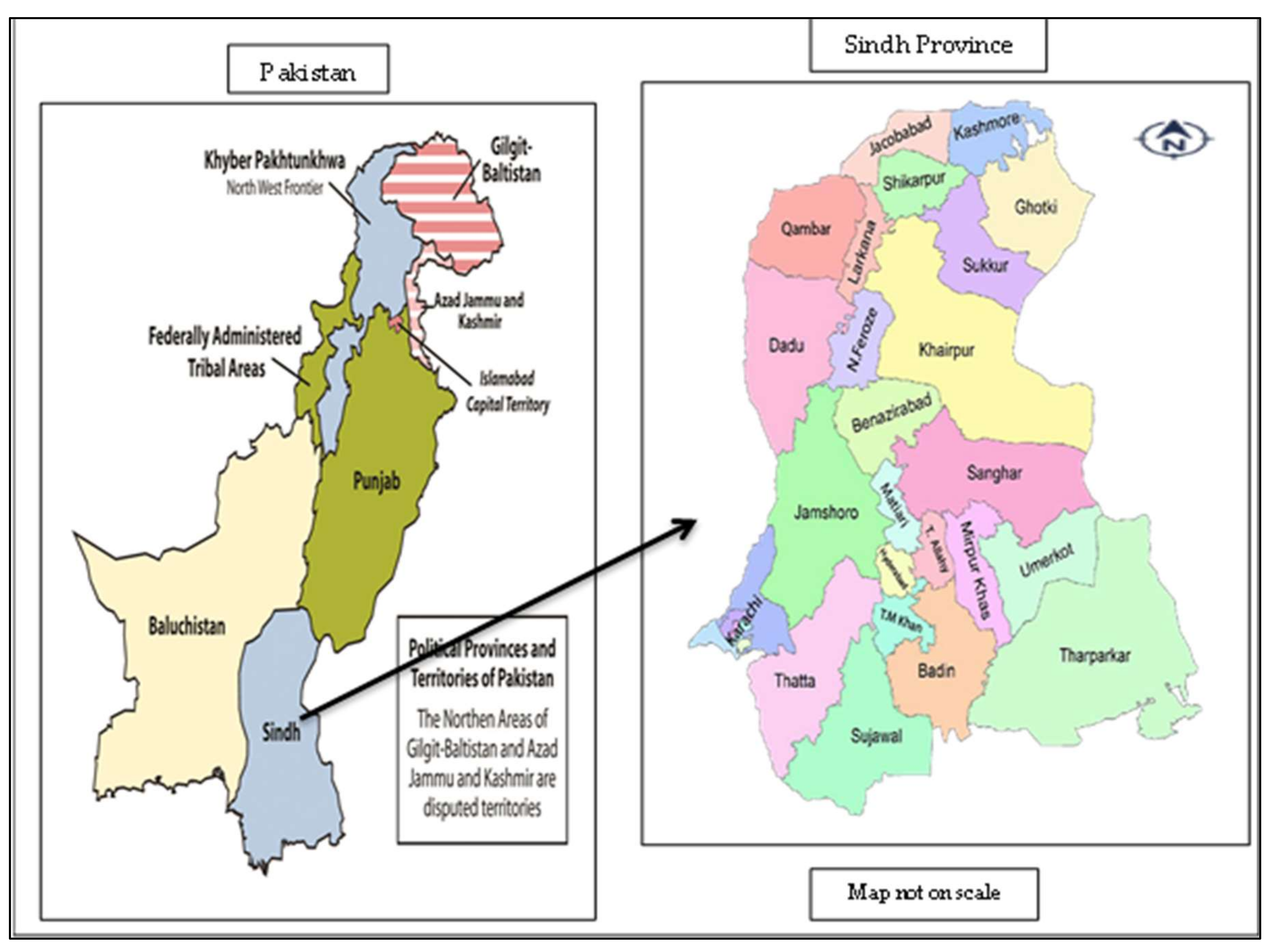
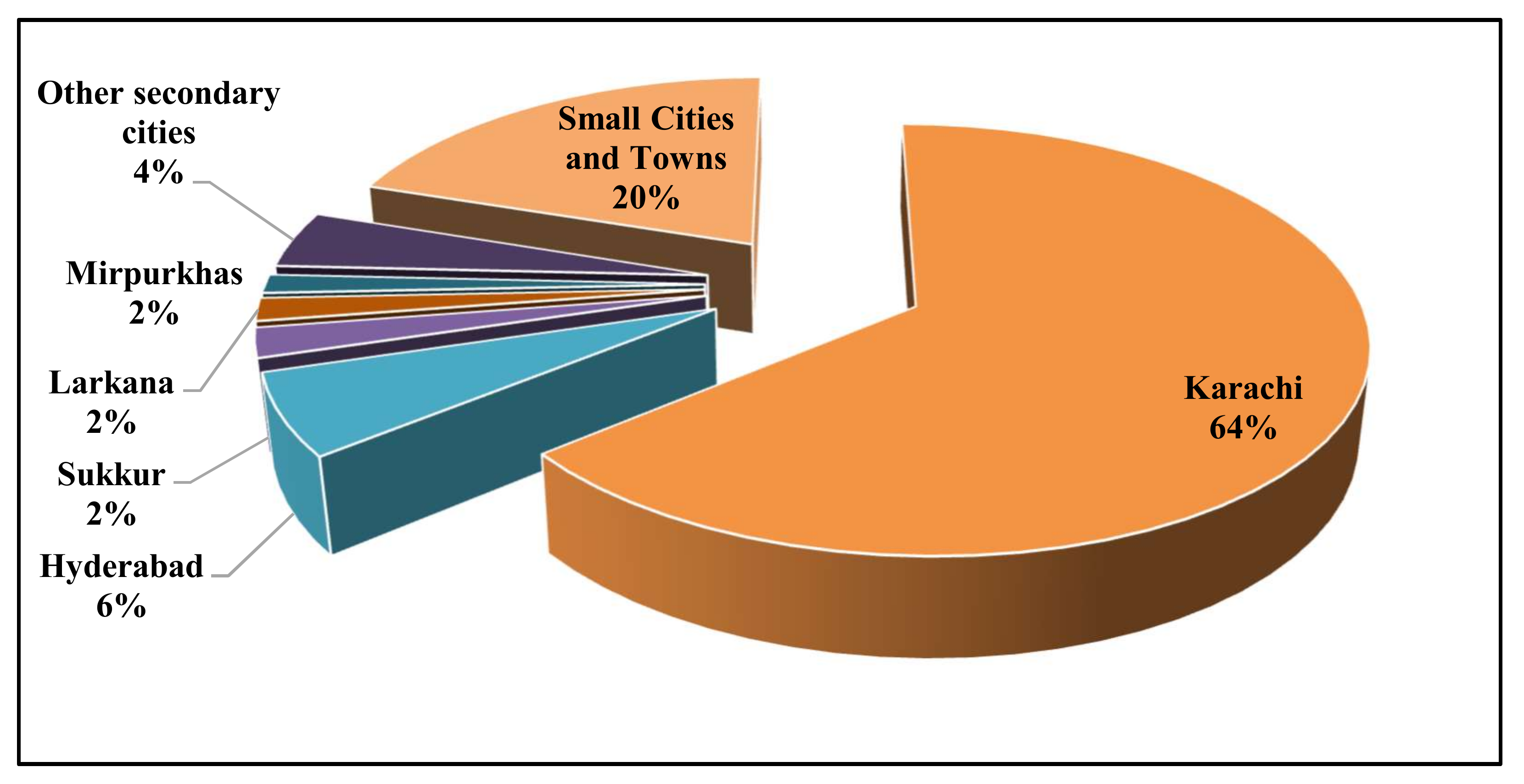
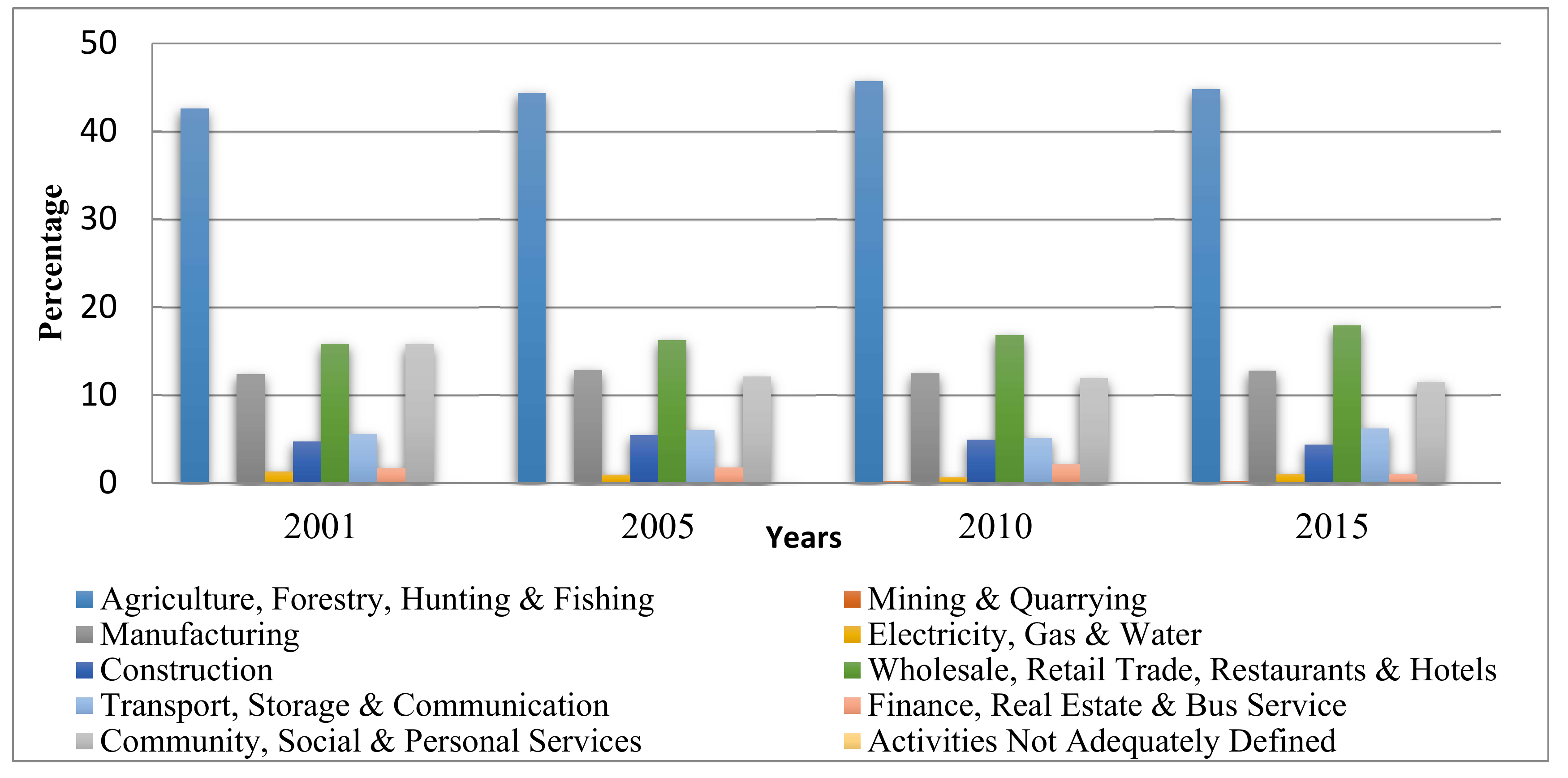
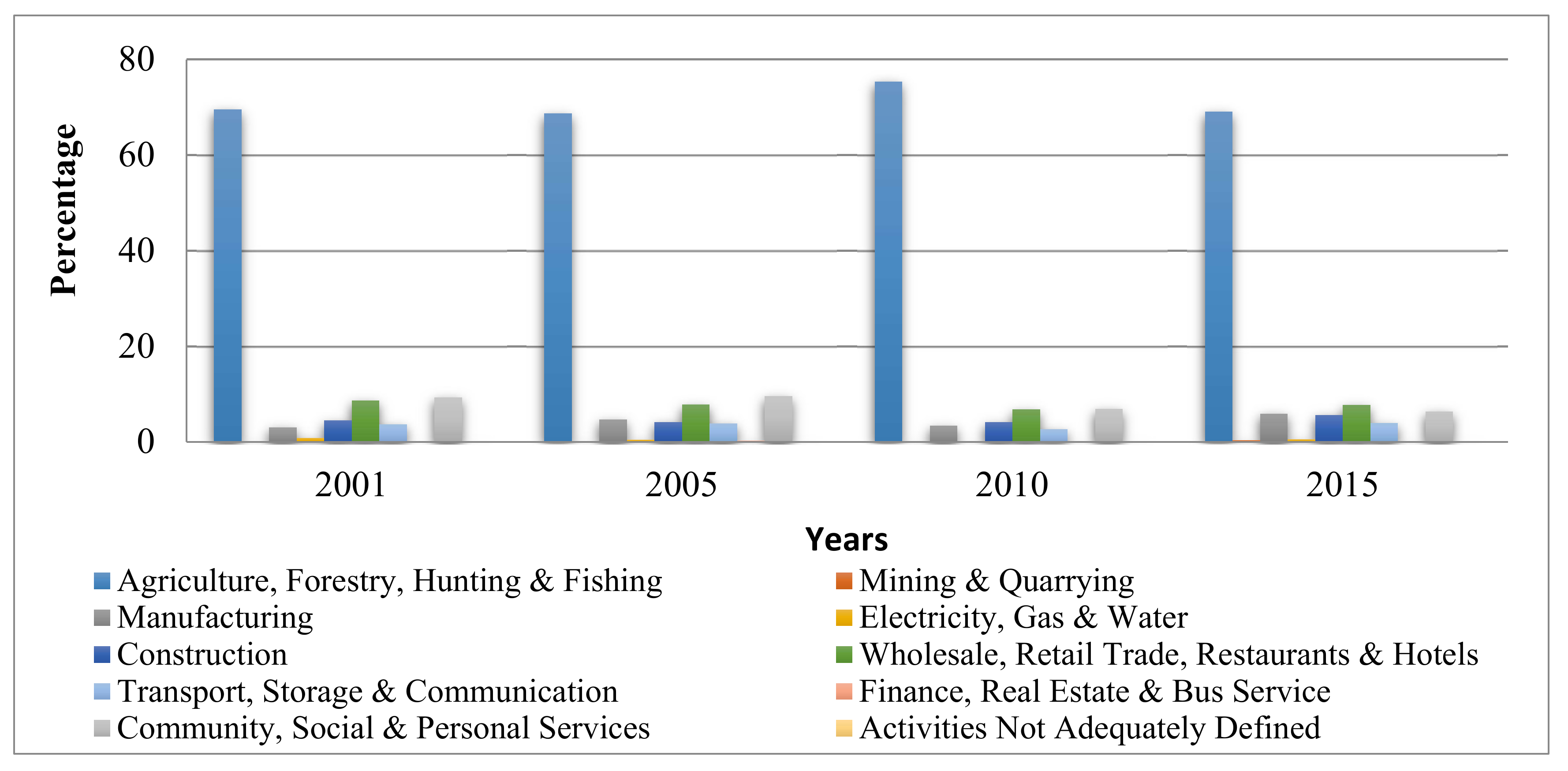
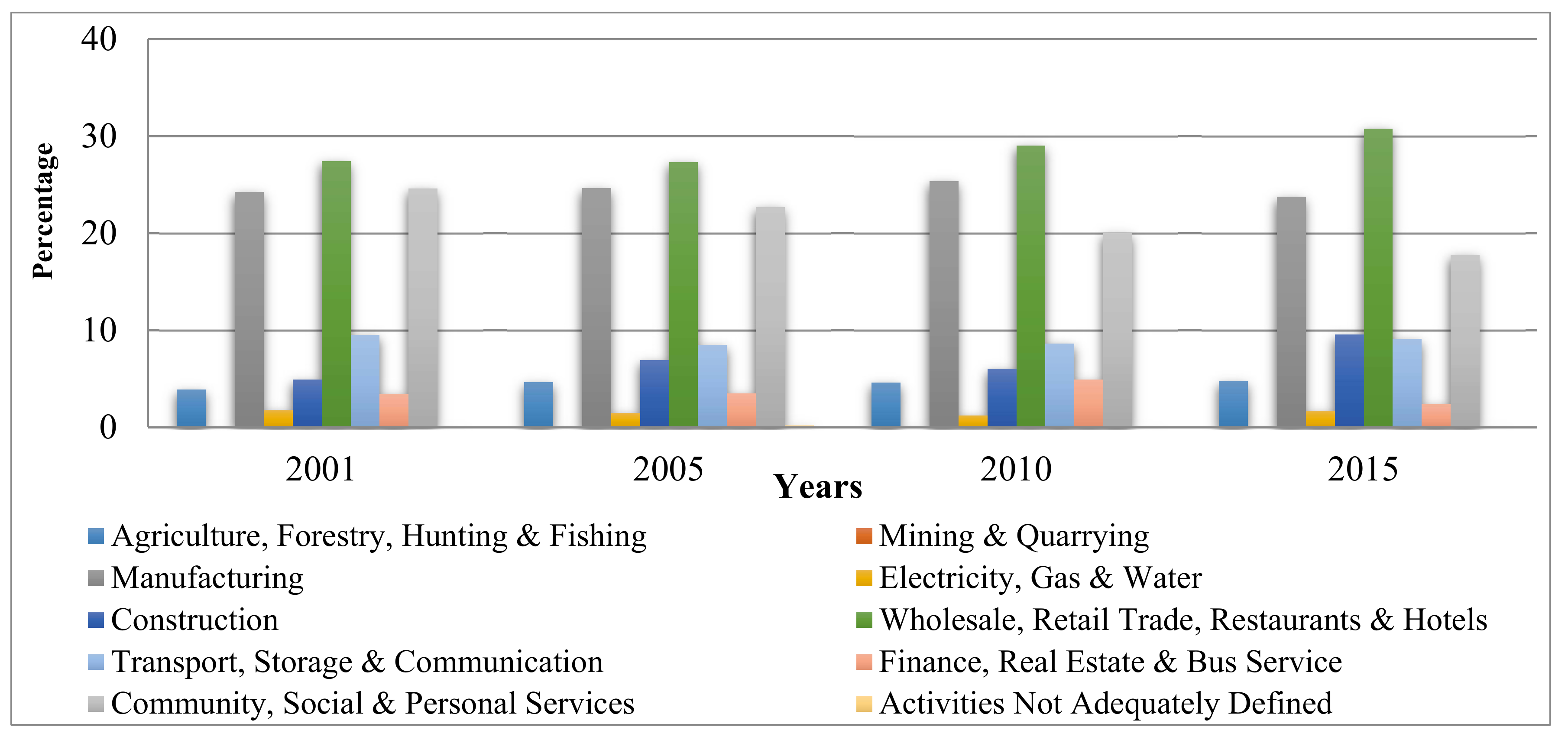
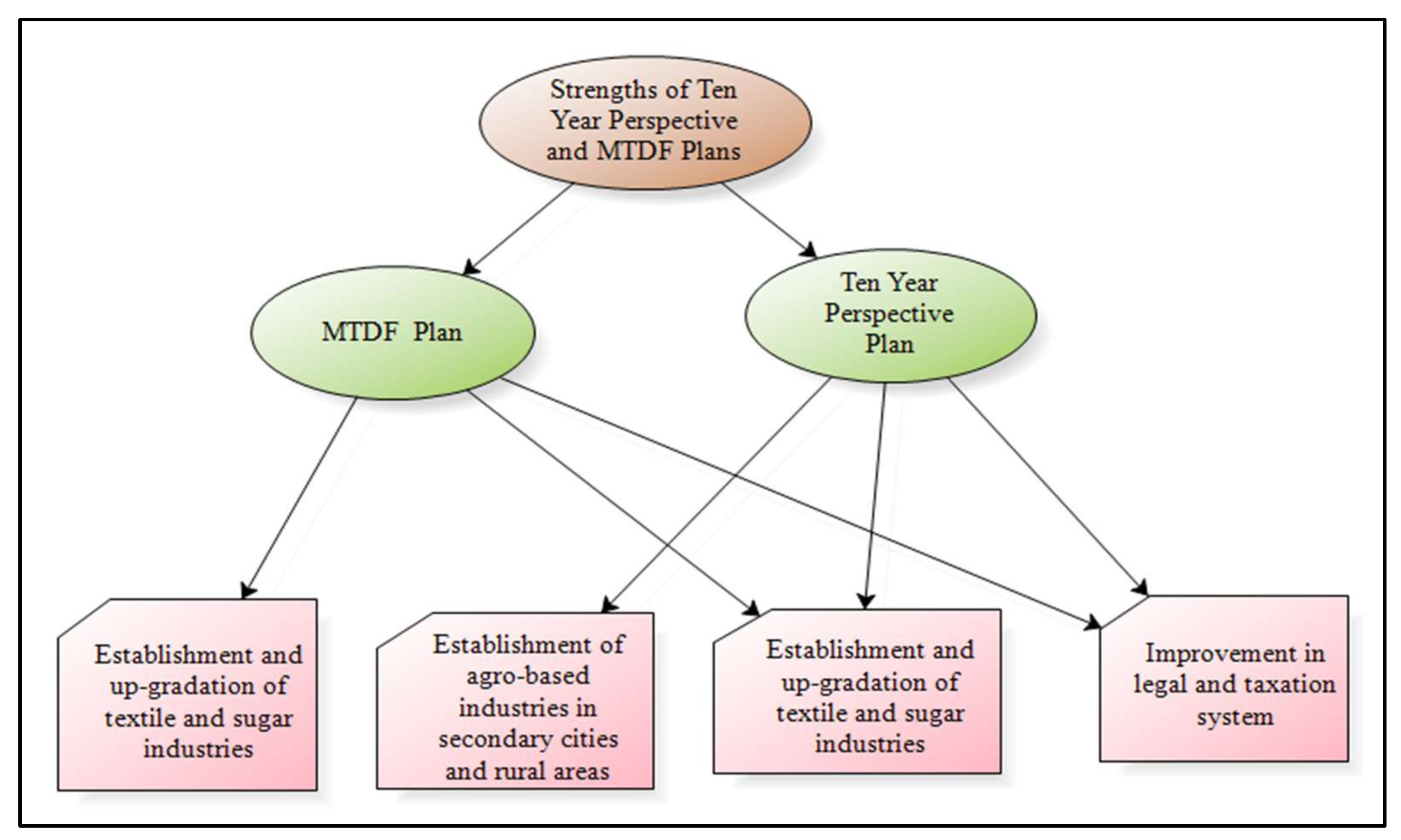
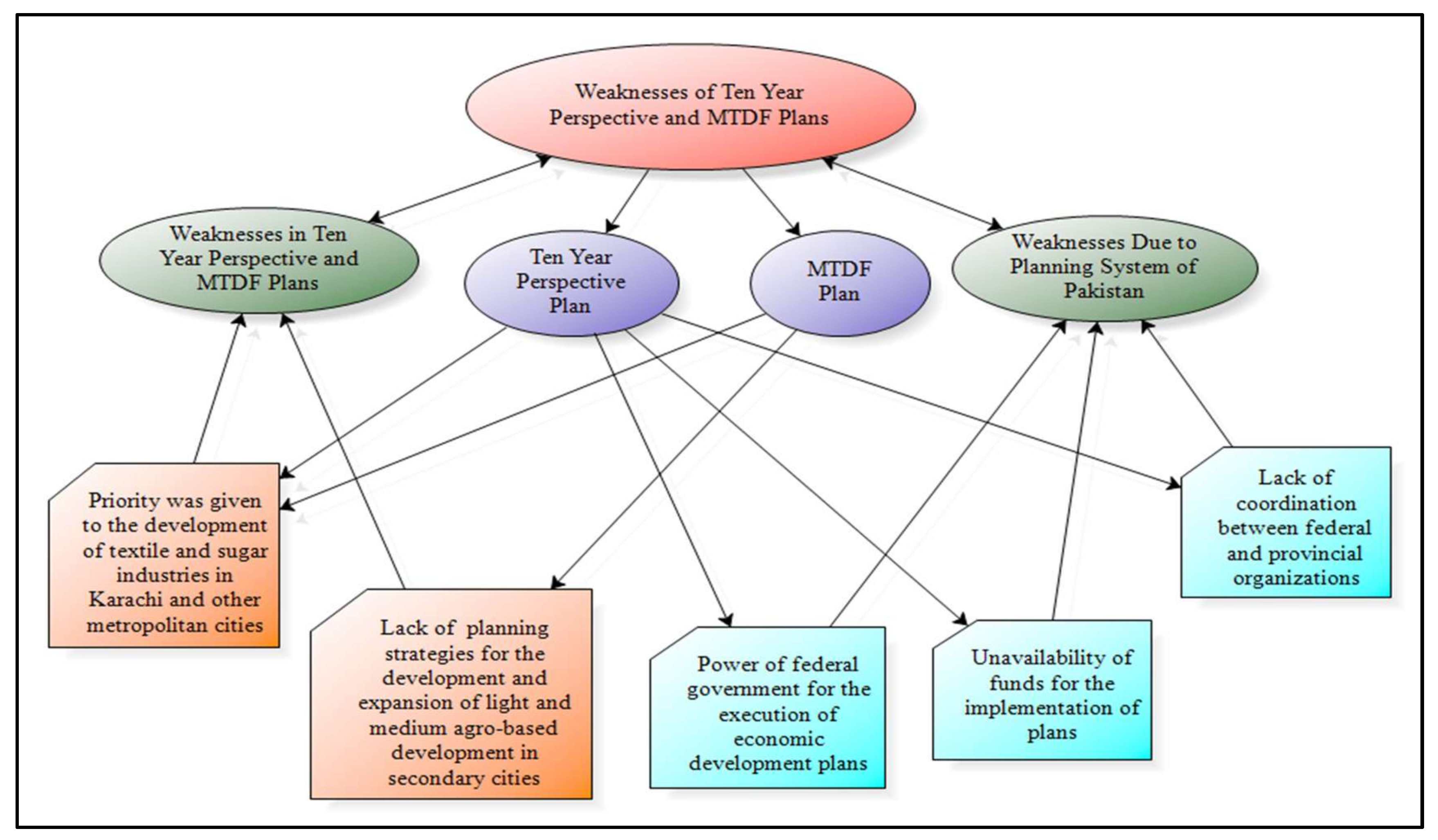
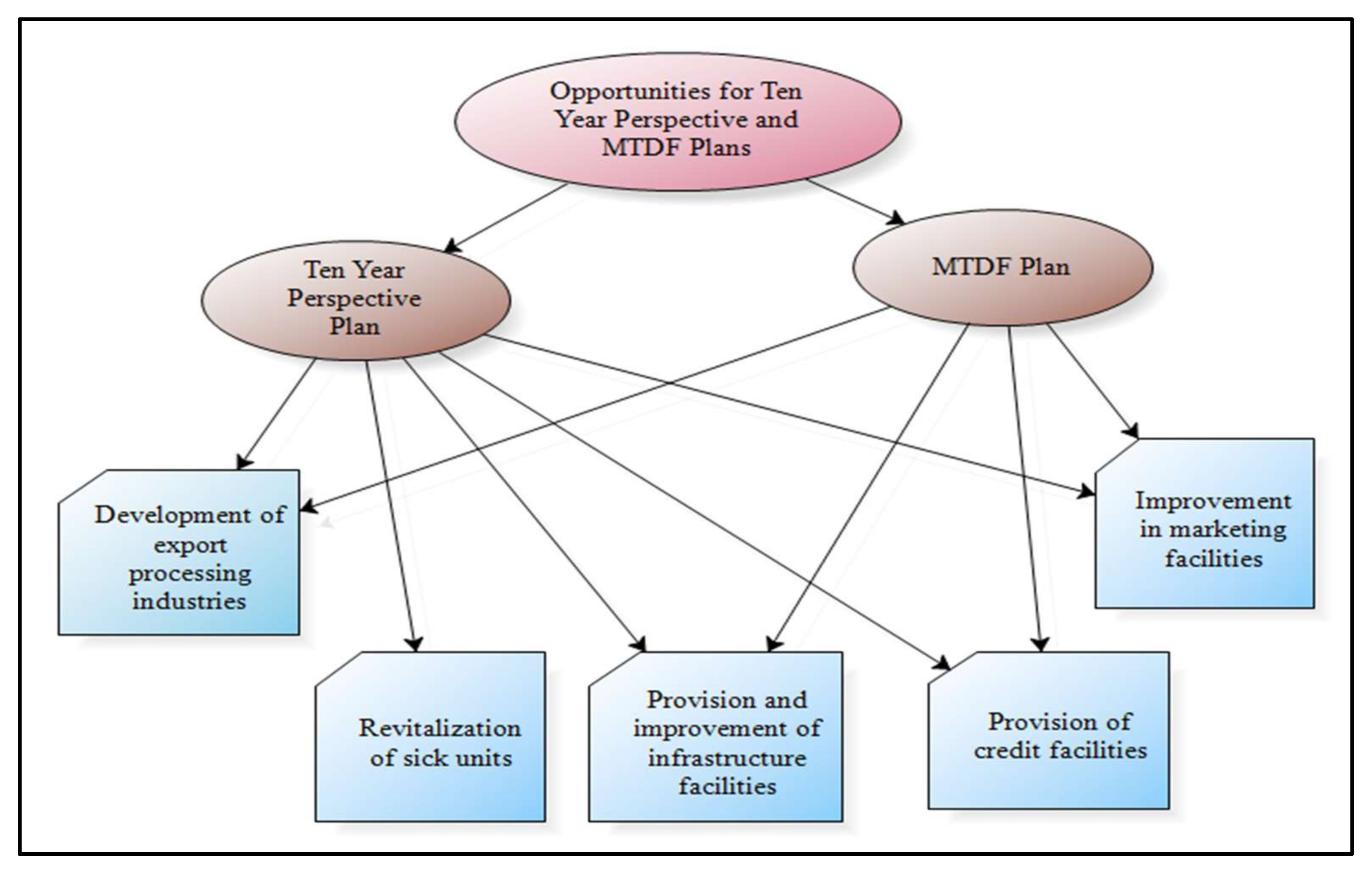
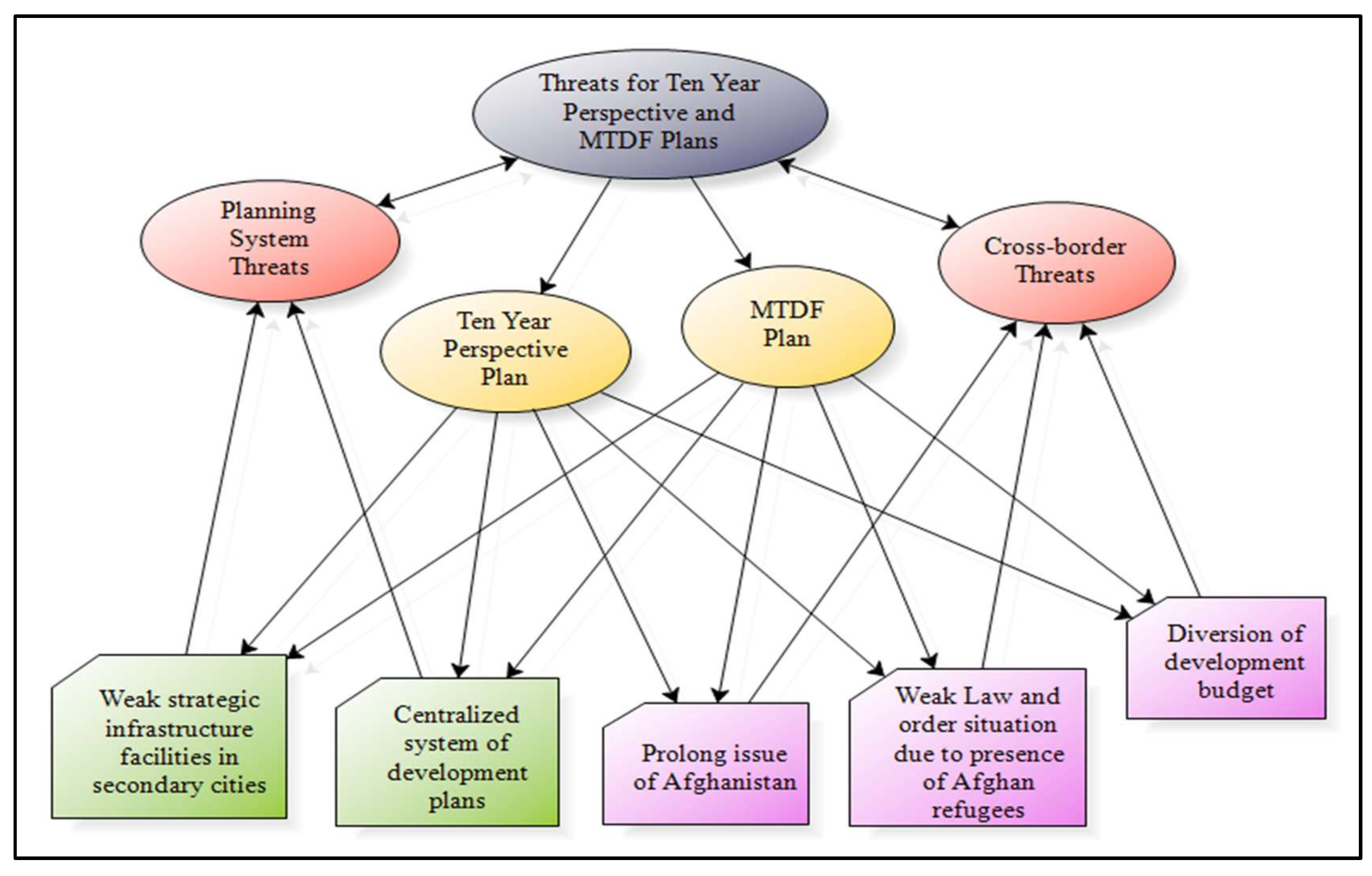
| Economic Sector | Designation | No of Interviewees |
|---|---|---|
| Agro-based | Director General Agriculture, Sindh | 2 |
| Director Agriculture | 5 | |
| Chairman Chamber of Commerce | 3 | |
| Chairman SITE, Sindh | 1 | |
| Chairman SIE, Sindh | 1 | |
| Professor Agriculture | 2 | |
| Deputy Director | 5 | |
| Assistant Director Agriculture | 5 | |
| Site Officers | 3 | |
| Site Officers | 3 | |
| Total | 30 |
| Strengths | Weaknesses |
| ◙ Expansion of agro-based industries through the development of small and medium labor-intense industries to offer more employment opportunities ◙ Establishment of agro-based by-product industries ◙ Coordination between *PCSIR and industries ◙ Establishment of *SMEDA for providing technical assistance to small and medium industries ◙ Establishment of Industrial Support Centers for agro-based and small scale industries ◙ Tax relief in customs on machinery | ◙ Main focus on textile and sugar industries ◙ Heavy unpaid loans on textile and sugar industries were written-off ◙Reliance on federal institutions for the release of funds to implement plans ◙ Lack of institutional collaboration in federal and provincial organizations ◙ Lack of finances to implement plans and programs |
| Opportunities | Threats |
| ◙ Development of farm to market roads ◙ Development and improvement of roads and other infrastructure services in industrial estates ◙ Export industries instead of local need based industries ◙ Revitalization of *sick units ◙ Establishment of Khushali Bank to provide loans to unemployed persons for setting agro-based and cottage industries | ◙ Inadequate agro-based infrastructure facilities in secondary cities to cope with the demand ◙ Centralized planning system ◙ Cross-border war in Afghanistan ◙ Migration of Afghani people to Pakistan ◙ Heavy burden on Pakistan’s economy to accommodate Afghan refugees ◙ Worsened law and order conditions in Northern areas of Pakistan due to the presence of Afghan refugees ◙ Diversion of sanctioned development budget for defense activities and settlement of Afghani people |
| Strengths | Weaknesses |
| ◙ Establishment of textile and sugar industries in different cities ◙ Up-gradation in technology and business skills through the establishment of common technical support centers in industrial areas ◙ Reforming of legal, taxation and institutional framework | ◙ The plan mainly focused on large scale industries such as textiles and sugar industries ◙ Lack of planning strategies for the development and expansion of light and medium agro-based industrial development ◙ Reliance on federal government for the release of capital for implementation of programs ◙ Lack of institutional collaboration in federal and provincial organizations ◙ Government failed to implement these plans and programs due to unavailability of finances |
| Opportunities | Threats |
| ◙ Provision of infrastructure, self-contained utilities ◙ Improvement in market access and product information in global context ◙ Improving access to financial resources and services through the development of Khushali Banks ◙ Enhancement of export-oriented industries in different cities | ◙ Weak strategic infrastructure facilities required for agro-based development in secondary cities ◙ Centralized planning system ◙ Continuing war in Afghanistan ◙ Migration of Afghani refugees in Pakistan ◙ Worse law and order conditions due to the presence of Afghan refugees ◙ Diversion of development budget for the accommodation of Afghan refugees and defense activities ◙ Heavy burden on Pakistan economy to accommodate Afghan refugees |
| Strengths (Sub-Themes) | Development Plans | No of Respondents | Percentage (n × 100/30) |
|---|---|---|---|
| Establishment of agro-based industries in secondary cities and rural areas | TYP | 27 | 90 |
| MTDF | -- | -- | |
| Establishment and up-gradation of textile and sugar industries | TYP | -- | -- |
| MTDF | 26 | 86.67 | |
| Development of technical assistance centers and organizations | TYP | 27 | 90 |
| MTDF | 24 | 80 | |
| Improvement in legal and taxation system | TYP | 27 | 90 |
| MTDF | 29 | 96.67 |
| Weaknesses (Main-Themes) | Weaknesses (Sub-Themes) | Development Plans | No of Respondents | Percentage (n × 100/30) |
|---|---|---|---|---|
| Weaknesses in TYP and MTDF plans | Priority was given to the development of textile and sugar industries in Karachi and other metropolitan cities | TYP | 24 | 80 |
| MTDF | 24 | 80 | ||
| Lack of planning strategies for the development and expansion of light and medium agro-based development in secondary cities | TYP | -- | -- | |
| MTDF | 25 | 83.33 | ||
| Weaknesses Due to Planning System of Pakistan | Power of federal government for the execution of economic development plans | TYP | 22 | 73.33 |
| MTDF | 23 | 76.67 | ||
| Lack of coordination between federal and provincial organizations | TYP | 23 | 76.67 | |
| MTDF | 23 | 76.67 | ||
| Unavailability of funds for the implementation of plans | TYP | 21 | 70 | |
| MTDF | 22 | 73.33 |
| Opportunities (Sub-Themes) | Development Plans | No of Respondents | Percentage (n × 100/30) |
|---|---|---|---|
| Development of export processing industries | TYP | 24 | 80 |
| MTDF | 23 | 76.67 | |
| Provision and improvement of infrastructure facilities | TYP | 18 | 60 |
| MTDF | 27 | 90 | |
| Provision of credit facilities | TYP | 27 | 90 |
| MTDF | 25 | 83.33 | |
| Revitalization of sick units | TYP | 23 | 86.67 |
| MTDF | -- | -- | |
| Improvement in marketing facilities | TYP | 22 | 73.33 |
| MTDF | 24 | 80 |
| Threats (Main-Themes) | Threats (Sub-Themes) | Development Plans | No of Respondents | Percentage (n × 100/30) |
|---|---|---|---|---|
| Planning system threats for ten-year perspective and medium-term development plans | Weak strategic infrastructure facilities in secondary cities | TYP | 23 | 76.67 |
| MTDF | 24 | 80 | ||
| Centralized system of development plans | TYP | 24 | 80 | |
| MTDF | 24 | 80 | ||
| Cross-border threats for ten-year perspective and medium-term development plans | Prolong issue of Afghanistan | TYP | 23 | 76.67 |
| MTDF | 24 | 80 | ||
| Weak law and order situation due to presence of Afghan refugees | TYP | 25 | 83.33 | |
| MTDF | 26 | 86.66 | ||
| Diversion of development budget | TYP | 25 | 83.33 | |
| MTDF | 26 | 86.66 |
© 2018 by the authors. Licensee MDPI, Basel, Switzerland. This article is an open access article distributed under the terms and conditions of the Creative Commons Attribution (CC BY) license (http://creativecommons.org/licenses/by/4.0/).
Share and Cite
Kalwar, S.; Dali, M.M.; Hassan, N. Development Framework for Agro-Based Industries in Secondary Cities of Sindh Province, Pakistan: SWOT Analysis of Ten-Year Perspective and Medium-Term Development Framework Plans. Sustainability 2018, 10, 1197. https://doi.org/10.3390/su10041197
Kalwar S, Dali MM, Hassan N. Development Framework for Agro-Based Industries in Secondary Cities of Sindh Province, Pakistan: SWOT Analysis of Ten-Year Perspective and Medium-Term Development Framework Plans. Sustainability. 2018; 10(4):1197. https://doi.org/10.3390/su10041197
Chicago/Turabian StyleKalwar, Saima, Melasutra Md Dali, and Norhaslina Hassan. 2018. "Development Framework for Agro-Based Industries in Secondary Cities of Sindh Province, Pakistan: SWOT Analysis of Ten-Year Perspective and Medium-Term Development Framework Plans" Sustainability 10, no. 4: 1197. https://doi.org/10.3390/su10041197
APA StyleKalwar, S., Dali, M. M., & Hassan, N. (2018). Development Framework for Agro-Based Industries in Secondary Cities of Sindh Province, Pakistan: SWOT Analysis of Ten-Year Perspective and Medium-Term Development Framework Plans. Sustainability, 10(4), 1197. https://doi.org/10.3390/su10041197




